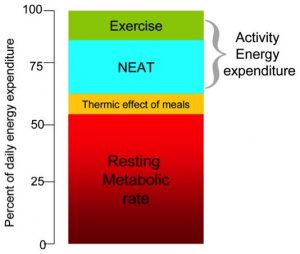
"Energy requirement and basal metabolism
Diet-induced thermogenesis refers to the extra energy that the body spends each time it eats food. Also for this reason, overweight people are often advised to divide their daily caloric ration into many small meals.
The energy expenditure linked to food thermogenesis corresponds, on average, to 10% of the daily calorie consumption. It is given by two components: compulsory thermogenesis and optional thermogenesis.
A part of the energy expended is destined to the physiological and metabolic processes related to digestion, absorption and processing of the nutrients introduced with the diet (Compulsory Thermogenesis)
Part of the energy is expended as a consequence of sympathetic nervous activation, induced, for example, by nerve substances (Facultative Thermogenesis)
The thermogenic effect of food varies according to the nutrients that constitute it:
Protides: they have by far the highest thermogenic value; the energy spent for the various processes described above amounts to 30% of the caloric intake provided by the proteins taken with food
Glucides: low thermogenic power (7% of the energy supplied)
Lipids: very low thermogenic power (3% of the energy supplied)
The thermogenic effect of proteins is higher than that of other nutrients, since the deamination of amino acids and the subsequent production of urea costs the body a lot of energy.
Even the nerve substances, such as caffeine and related molecules (contained in tea, cocoa, guarana, etc.), have a moderate thermogenic power.
Physical Activity
Physical activity is the most variable item of energy expenditure, as it depends on the person's work habits and lifestyle.
Generally speaking, in a sedentary individual, the energy expenditure associated with physical activity corresponds on average to 30% of the daily calorie expenditure.
However, it should be borne in mind that the energy consumption associated with physical activity is closely related to the body mass of the subject. The more this is greater and the higher will be the calorie expenditure associated with physical effort. This is obviously due to the greater energy demand necessary to move the high body size; moreover, it should be remembered that the adipose tissue acts as a thermal insulator, preventing the dispersion of the heat produced. Overweight people are therefore forced to spend more energy to eliminate the heat developed during physical activity.
Thermoregulation
Human beings are homeotherms, that is, they must keep their internal temperature within a fairly constant range of values. All this costs the body a lot of energy, which is necessary for:
maintain internal homeothermia despite fluctuations in external temperature
eliminate the internal heat produced by metabolism and muscle activity
Thermogenesis and metabolism
Weight loss, yo-yo effect and adipose-specific thermogenesis


























